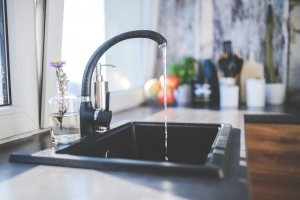 Having clean, healthy water in your home is crucial for your well being. If you’ve noticed discoloration in your water or funny smells, it’s important to have your water tested and understand the causes of these issues. Once these are addressed, you’ll be able to improve the water quality in your home in just a few easy steps.
Having clean, healthy water in your home is crucial for your well being. If you’ve noticed discoloration in your water or funny smells, it’s important to have your water tested and understand the causes of these issues. Once these are addressed, you’ll be able to improve the water quality in your home in just a few easy steps.
Homes Using City Water
If your home uses city water, any water problems are most likely to originate on your property. Start by taking a look at your pipes to see if there is are any leaks or corrosion build up. Water pipe leaks will cause low water pressure and by simply repairing or replacing the section of pipe, the problems should resolve.
With corrosion, the water pressure in your home can not only because extremely low due to pipe blockage, but the water can become discolored due to the water running through the corroded area.
Homes Using Well Water
If you’re experiencing low quality water and your home utilizes a well, issues can arise due to contaminants and leaks. Once you have the water tested, there are various ways to improve the water, including water treatments.
If the water isn’t contaminated but there is a leak, it’s crucial to have it repaired right away to ensure that the water does not get contaminated by dirt or sediment.
Improving the Water Quality
Once the cause of poor water quality is addressed, there are five common ways to quickly improve the water quality once any repairs are made.
1. Water Filtration System
Water filtration systems can be used in homes utilizing both well water and city water to help remove impurities and improve the taste of the water. A simple faucet purifier can be purchased at your local hardware store for short money and the installation process is quick and easy.
2. Whole-House Filtration System
Whole-house filtration systems not only filter faucet water, but also filter the water for showers and laundry as well. These do cost more, averaging around $1,500, and are installed on the main water supply by a plumbing professional. With a whole-house filtration system, a pre-filter and main system will be needed in order to properly filter the water coming into your home.
3. Point-of-Entry Filters
If the water in your home is discolored, tastes funny, or has an odor to it but there are no contaminants or leaks causing the issue, a point-of-entry filter can be installed on the water supply line that supplies water to your refrigerator and faucet is your best option. Point-of-entry filters are easy to install and if you only need a filter on your faucet, there are options to be able to install the filter directly on the faucet.
4. Reverse Osmosis Systems
A reverse osmosis system is installed on your sink and work by passing water through several membranes that remove bacteria, sediment, and pollution. The membranes will leave the oxygen and naturally occurring minerals to allow you delicious drinking water. This system is more complex and will need to be installed by a plumbing professional.
5. Distillers
Distillers remove all impurities from water, including oxygen and naturally occurring minerals. They work by heating the water to create stem before condensing it into pure water. Distillers are the least common type of filtration system for homeowners looking to improve their water quality.
To set up your appointment with A+ Plumbing, Heating and Cooling to have your water tested and a filtration system installed, give us a call today at (603) 518-5777.